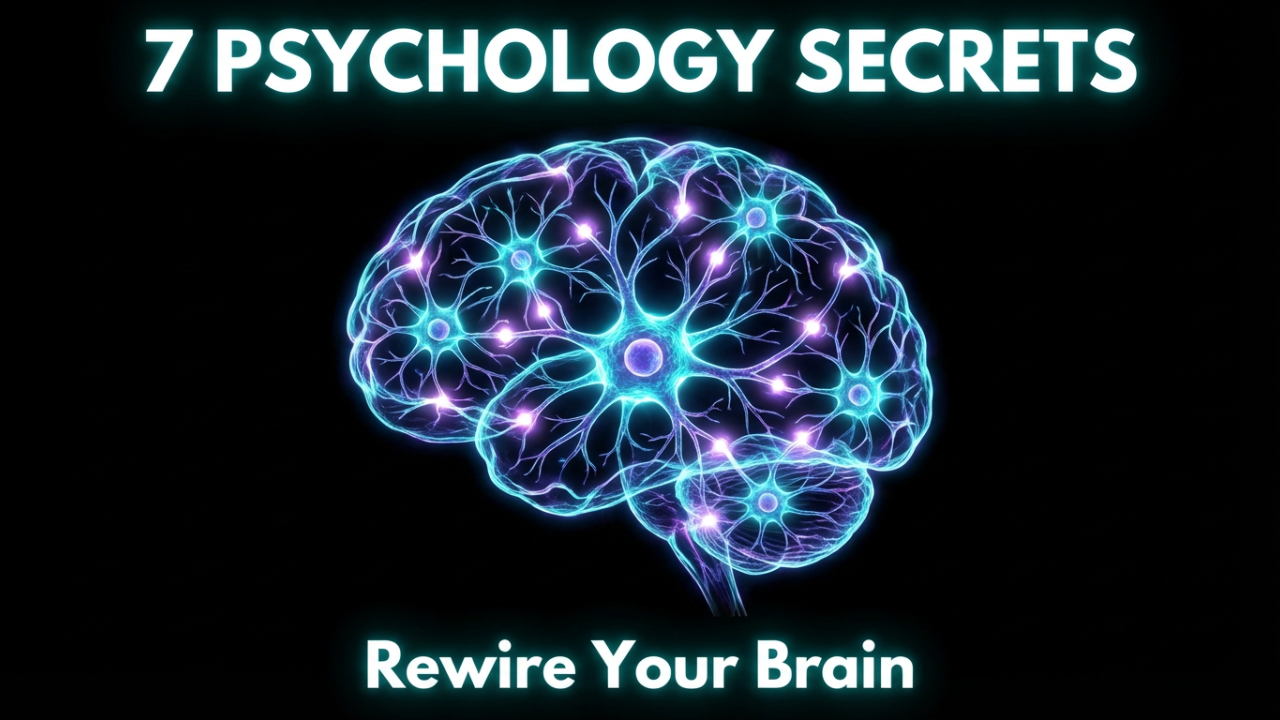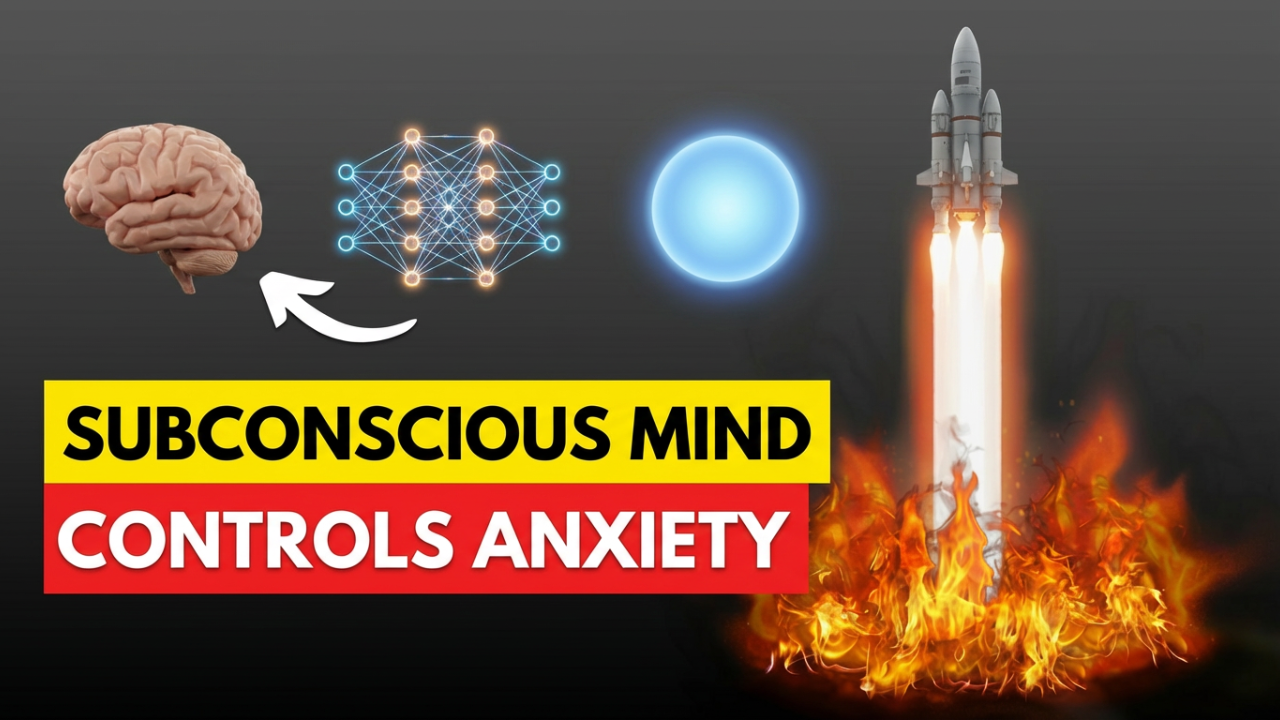You know the feeling… it’s 3 AM, and your brain is replaying a clumsy conversation from five days ago on an endless, cringeworthy loop. Or maybe you’re stuck in a “what if” spiral about the future, your mind generating catastrophic scenarios with the speed of a supercomputer. You’re just trying to sleep, but your brain is busy producing the season finale of your personal drama series, complete with worst-case scenarios and imaginary arguments you’ll never have. It’s exhausting. It’s paralyzing. And it can make you feel completely alone, trapped inside your own head.
What if I told you that this isn’t a personal failing? That it’s not some character flaw or a sign of weakness? It’s a specific, predictable pattern of activity in your brain. A network of circuits that has, for a variety of reasons we’re about to explore, simply gotten stuck on a loop.
In this article , we’re going to look at the neuroscience of overthinking. I’ll show you exactly *why* your brain gets locked into these repetitive, anxious spirals. We’ll explore the specific brain networks running the show, the chemical signals that can fuel the fire, and why it feels so impossible to just “snap out of it.”
But we’re not going to stop there. Understanding the *why* is only the first step. The second, and most important step, is learning the *how*. So after we’ve unpacked the science, I’m going to give you eight powerful, science-backed strategies you can use right away to quiet the noise, break the cycle, and reclaim your mental peace. This isn’t about fighting your brain; it’s about learning to work *with* it. So, if you’re ready to finally understand the mechanics of your own mind and learn how to steer it away from the cliff of overthinking, you’re in the right place.
This book is scientific documentary of the Kingdom of God.
Section 1: The “Why” – Unpacking the Overthinking Brain
Alright, let’s demystify what’s actually happening in your head when you’re stuck in a thought loop. First off, overthinking isn’t just ‘thinking too much.’ It’s a specific kind of thinking—it’s repetitive, it’s focused on you, and it’s usually negative. And it’s driven by a core network in your brain that’s become a little too good at its job.
**The Master of Mind-Wandering: The Default Mode Network (DMN)**
I want you to meet the main character in our story of overthinking: the Default Mode Network, or DMN. You can think of the DMN as your brain’s “screensaver” mode. It’s a collection of brain regions that fires up when you’re not focused on a specific, external task. When you’re showering, driving a familiar route, or lying in bed, your mind starts to wander. That’s the DMN kicking into gear.
Now, the DMN isn’t inherently bad. Evolutionarily, it’s incredibly useful. It’s the network that lets you reflect on your past, plan for your future, and understand your place in the social world. It’s your brain’s internal storyteller, constantly weaving together memories and “what ifs” to create your sense of self.
The problem starts when this network becomes *overactive*. In people who overthink, and especially in those with anxiety and depression, the DMN doesn’t quiet down when it’s supposed to. Instead of being a gentle screensaver, it becomes a rogue program that hijacks your mental desktop, running an endless slideshow of past mistakes and future worries. It dredges up negative memories, makes you dwell on your emotional state, and makes you anxious about how other people see you. It’s like having a social media feed in your head that’s curated by your worst fears, and you can’t log off.
This overactivity explains why overthinking feels so automatic and so personal. The DMN’s whole job is self-referential thinking—it’s all about ‘me, myself, and I’. So when it goes into overdrive, the thoughts are intensely focused on your perceived flaws, your past embarrassments, and your potential failures. This is why overthinking is so draining; you’re running the most energy-intensive screensaver imaginable.
So, the first piece of the puzzle is an overactive Default Mode Network, acting like an internal narrator that just won’t shut up. But why can’t we just tell it to be quiet? That brings us to our second player.
**The Unresponsive “Stop” Button: The Frontoparietal Network (FPN)**
If the DMN is the brain’s daydreaming storyteller, then the Frontoparietal Network, or FPN, is the brain’s CEO. Scientists call it a ‘task-positive network’. This network is in charge of your “executive functions”: focused attention, problem-solving, and—most importantly for us—tuning out irrelevant thoughts. The FPN is what you use when you’re concentrating on a spreadsheet or learning a new skill. It’s your focus-and-control center.
Here’s the critical part: the DMN and the FPN generally have an oppositional relationship. Think of them like two kids on a seesaw. When one goes up, the other should go down. When you’re focused on a task (FPN up), your mind-wandering should decrease (DMN down). When you relax and let your mind drift (DMN up), your intense focus subsides (FPN down).
In a brain prone to overthinking, that seesaw is broken. The DMN is so persistently loud that it shoves the FPN down. The noisy, self-critical passenger (DMN) is shouting so loudly that the driver (FPN) can’t focus on the road. This means your brain’s ability to disengage from the stream of negative thoughts is seriously weakened. You *try* to “just stop thinking about it,” but the very network responsible for that action—the FPN—is being drowned out.
It becomes a vicious cycle. The overactive DMN generates a storm of repetitive thoughts, and the underactive FPN leaves you without the mental tools to steer your attention away from it. You feel stuck because, on a neural level, you *are* stuck. The part of your brain that should be helping you switch channels is offline, while the channel playing your greatest fears is stuck on repeat at maximum volume.
**The Overactive Alarm System: The Amygdala and Salience Network**
So we have a hyperactive storyteller and a weak CEO. But what gives these thought loops such a powerful, anxiety-ridden emotional punch? For that, we need to introduce two more players: the Amygdala and the Salience Network.
The amygdala is your brain’s ancient fear detector. It’s constantly scanning for potential threats. In a healthy state, it’s a vital survival tool that makes you jump back on the curb if a car honks. The problem for overthinkers is that the amygdala is often hyper-reactive. It starts treating your *thoughts* as if they were actual threats.
When your DMN dredges up a “what if” scenario about losing your job, your amygdala doesn’t see it as a harmless thought. It flags it as a real and present danger. This triggers a stress response: your heart might race, your breathing gets shallow, and your body floods with cortisol. Your amygdala essentially reacts to a cringe-worthy memory from 2014 with the same alarm it would for a tiger entering the room. This intense emotional reaction makes the thought feel incredibly urgent, which in turn tells the DMN to keep focusing on it.
This is where the Salience Network comes in. The Salience Network is like the brain’s newsroom editor. Its job is to decide what is most “salient” or important and deserves your attention. It’s the switchboard that toggles between your internal world (DMN) and the external world (FPN).
In an overthinking brain, this Salience Network is dysregulated. Because the amygdala is screaming “THREAT! DANGER!” about your internal thoughts, the Salience Network dutifully directs all your attention inward. It keeps switching you *back* to the anxious thoughts, thinking it’s helping you deal with a critical issue. It’s like having a breaking news alert that never stops flashing for a story that’s happening entirely inside your head.
**The Missing “Off” Switch: The Neurochemistry of Overthinking**
Finally, let’s look at this from a chemical level. One of the most important players here is GABA, or Gamma-aminobutyric acid.
GABA is the brain’s primary *inhibitory* neurotransmitter. Its job is to calm things down. It’s the “chill out” signal, the brake pedal for your neurons.
Fascinating new research is revealing a strong link between GABA levels and the ability to control unwanted thoughts. Specifically, studies have found that lower levels of GABA in the hippocampus—a key memory hub in the DMN—are associated with more difficulty suppressing intrusive thoughts. With less GABA, there’s less inhibition. There are fewer “stop” signals being sent. The part of your brain that should be applying the brakes can’t do its job as effectively because the chemical messenger it needs is in short supply.
Think of it like this: your train of thought is careening down a hill. GABA is the braking system. If your GABA levels are low, it’s like having worn-out brake pads. You can see the hairpin turn coming, you *want* to slow down, but you just don’t have the chemical mechanism to stop the momentum. This helps explain why overthinking can feel so involuntary and difficult to rein in with sheer willpower.
So, let’s put it all together. You have a hyperactive DMN generating endless worrisome thoughts. You have a suppressed FPN that can’t pull your attention away. You have a hypersensitive amygdala treating these thoughts as real threats, and a dysregulated Salience Network keeping your focus locked on the internal chaos. And underneath it all, a potential shortfall in the inhibitory neurotransmitter GABA leaves you without a reliable chemical brake.
When you look at it this way, it becomes clear. Overthinking isn’t a moral failing. You’re not broken. You’re experiencing a predictable, though painful, pattern of brain activity. But here’s the good news—the most important message of this video: brain circuits are not set in stone. The principle of neuroplasticity means we can intentionally and systematically train our brains to build new pathways. Pathways of calm, focus, and mental control.
And that is exactly what we are going to do next.
Transition
So now that you have a clearer picture of the neural architecture of overthinking, let’s shift from the problem to the solution. Understanding the science is empowering, but applying it is what changes your life. We’re moving into the “how”—a series of eight powerful, science-backed strategies designed to target the very brain networks we just discussed. These aren’t just feel-good tips; they are targeted exercises for your brain. Let’s begin.
Section 2: The “How” – 8 Actionable Strategies to Reclaim Your Mind
**Strategy 1: Label and Defuse – The Metacognitive Shift**
The first strategy is deceptively simple: notice and name your overthinking. This comes from Metacognitive Therapy, which isn’t about changing your thoughts, but changing your *relationship* to them.
Here’s the action: The moment you catch yourself in a spiral, mentally take a step back and label it. Say to yourself, “Ah, here is overthinking.” or “I’m having the thought that I messed up.” or even, “My DMN is doing its negative self-talk thing again.”
Why does this work? This simple act of labeling does two profound things. First, it creates psychological distance. When you say, “I am a failure,” you are fused with the thought. It’s your reality. But when you say, “I am *noticing* that I’m having the thought that I am a failure,” you are no longer the thought. You are the *observer* of the thought. You’ve stepped out of the river of thinking and onto the bank, just watching it flow by.
Second, on a neural level, this act of labeling is a direct exercise for your brain’s CEO, the Frontoparietal Network (FPN). You’re giving your FPN a job: to observe and categorize your mental state. This act of conscious attention strengthens the FPN and, because of that seesaw relationship we talked about, it helps to dial down the activity of the Default Mode Network (DMN).
**Strategy 2: Schedule Your Worries – The Containment Protocol**
Our brains hate unresolved loops. Overthinking often comes from a feeling that we need to solve a problem *right now*, so our mind chews on it endlessly. This strategy fights that by giving your worries an appointment. It’s called “structured worry time.”
Here’s the action: Designate a specific, limited time each day—say, 15 minutes at 5:00 PM—as your official “Worry Window.” Get a notebook. During the day, whenever a recurring worry pops into your head, don’t get sucked in. Instead, tell your brain, “Thanks for the reminder, but this isn’t the time. I’ll give this my full attention at 5:00 PM.” Then, jot the worry down.
When your Worry Window arrives, set a timer for 15 minutes. During this time, you have full permission to worry. Go through your list. Ruminate. Catastrophize. But—and this is key—when that timer goes off, you’re done. Close the notebook and physically get up and do something else. The session is over.
Why does this work? By postponing the worry, you’re breaking the immediate link between having a thought and being consumed by it. You are teaching your brain that you control when you engage with these thoughts, not the other way around. This strengthens your FPN. It also paradoxically calms the amygdala, because you aren’t trying to suppress the thought; you are validating it—”This is important enough for its own time slot”—which allows your brain to let it go in the moment.
**Strategy 3: Engage the Senses – The 5-4-3-2-1 Grounding Technique**
Overthinking traps you in your head, in the abstract world of the DMN. The fastest way out is to anchor your attention in the physical reality of the present moment. The 5-4-3-2-1 technique is a powerful way to do this.
Here’s the action, and you can do it right now. Wherever you are, pause and gently notice:
* **Five** things you can **see**. Don’t just glance. Look at the details. The texture of your desk, the way light hits a glass, the precise color of a book.
* **Four** things you can **feel**. The pressure of your feet on the floor. The texture of your clothes. The coolness of the air. The solidness of the chair supporting you.
* **Three** things you can **hear**. The hum of a computer. Distant traffic. The sound of your own breathing. Tune into each sound, one at a time.
* **Two** things you can **smell**. Maybe the scent of coffee or soap. If you can’t smell anything, just imagine two of your favorite smells.
* **One** thing you can **taste**. The lingering taste of your last drink, or just the neutral sensation in your mouth.
Why does this work? This isn’t just a distraction; it’s a neural reboot. The exercise forces a hard shift in your brain’s attention. To complete it, you have to disengage from the internal DMN and activate the parts of your brain that process external sensory information. You are manually overriding your Salience Network, telling it, “Hey, this sensory information right here is the most important thing to focus on.” This starves the overthinking loop of the one thing it needs to survive: your attention.
***
**Soft CTA**
If these first few strategies are making sense to you, take a quick second to click the ‘like’ button below. It’s a small thing, but it tells YouTube that this is valuable information, which helps this video reach more people who might be stuck in that 3 AM spiral. Your click could genuinely help someone else find this guide. Thank you for that. Now, let’s get back to our toolkit.
***
**Strategy 4: The Cognitive Reframe – Questioning the Narrative**
Overthinking is often built on cognitive distortions—thoughts that feel true but aren’t really based in reality. We can use techniques from Cognitive Behavioral Therapy (CBT) to put these thoughts on trial.
Here’s the action: When you catch a negative, repetitive thought, become a gentle detective. Ask it some questions. Let’s use the thought: “I said something so stupid in that meeting, everyone thinks I’m an idiot.”
1. **The Evidence Question:** “What’s the actual evidence *for* this thought? What’s the evidence *against* it?” (Against: No one actually said anything negative. Sarah even nodded when I spoke. The meeting moved on immediately.)
2. **The Alternative Question:** “Is there another, more balanced way to look at this?” (Alternative: Maybe my wording was a bit clumsy, but most people are focused on their own stuff and probably didn’t even notice. Or if they did, they’ve already forgotten.)
3. **The Usefulness Question:** “Is obsessing over this helping me? Or is it just making me feel miserable?” (Answer: Not helpful. It’s just fueling my anxiety.)
4. **The Friend Question:** “What would I tell my best friend if they came to me with this exact thought?” (Answer: I’d tell them they’re being way too hard on themselves and that one awkward moment doesn’t define their intelligence.)
Why does this work? This is a direct workout for your FPN, the brain’s CEO. You’re using logic and perspective-taking to dismantle the simplistic narratives generated by the DMN and amygdala. This weakens the believability of the thought and, over time, trains your brain to automatically challenge these distortions before they can spiral. You’re essentially fact-checking your own fears.
**Strategy 5: The GABA Boost – The Power of Rhythmic Breathing**
Remember how we talked about GABA as the brain’s “brake pedal”? While we can’t directly control our GABA levels, we can use our bodies to send powerful calming signals to our nervous system. The most direct way to do this is through controlled breathing.
Here’s the action: The next time you feel the physical signs of anxiety that come with overthinking—a tight chest, shallow breathing—try “Box Breathing.” It’s simple and you can do it anywhere.
* Slowly inhale through your nose for a count of four.
* Gently hold your breath for a count of four.
* Slowly exhale through your mouth for a count of four.
* Hold at the bottom for a count of four.
* Repeat this cycle for at least a few minutes.
Why does this work? Slow, rhythmic breathing directly stimulates the vagus nerve, which is a major part of your parasympathetic nervous system—your body’s “rest and digest” system. Activating this system counters the “fight or flight” response triggered by the amygdala. As your body relaxes, it sends a feedback signal to your brain: “We are safe.” This helps quiet the amygdala’s alarm bells, reducing the emotional fuel for the overthinking fire. It’s a bottom-up approach: you use your body to calm your mind.
**Strategy 6: Action as the Antidote – The Five-Minute Rule**
Overthinking thrives on inaction. The longer you sit still with a thought, the bigger it gets. Action, no matter how small, is the enemy of rumination. This is where the Five-Minute Rule comes in.
Here’s the action: When you’re stuck in a loop about something you need to do (“I have to write that report, it’s going to be so hard…”), commit to working on it for just five minutes. Set a timer. Anyone can do anything for five minutes. If you’re overthinking a worry that doesn’t have a task, the rule is to do five minutes of *any* productive, physical action. Wash one dish. Reply to one simple email. Do ten push-ups. Tidy one corner of your room.
Why does this work? Behaviorally, it breaks through the inertia and procrastination that feed anxiety. Neurologically, taking action requires you to switch from the passive DMN to your task-oriented FPN and motor cortices. You’re physically demonstrating to your brain that you are not helpless. You are proving that you can function *despite* the anxious thoughts. This shifts you from being a passive victim of your thoughts to an active agent in your life.
**Strategy 7: The Perspective Shift – The 10-10-10 Rule**
Overthinking blows our problems out of proportion. Our amygdala is terrible at long-term perspective. This strategy deliberately forces that perspective.
Here’s the action: When you’re consumed by a worry, ask yourself three questions:
* How will I feel about this in **10 minutes**?
* How will I feel about this in **10 months**?
* How will I feel about this in **10 years**?
Let’s apply it. You sent an email with a typo to your boss. Your mind is spiraling.
* In 10 minutes: You’ll still feel anxious.
* In 10 months: Will you even remember this? It’s highly unlikely. The event will have zero relevance.
* In 10 years: The idea that this will matter in a decade is almost laughable.
Why does this work? This technique, known as temporal distancing, forces you to engage your prefrontal cortex to travel mentally in time. This cognitive effort pulls resources away from the amygdala’s immediate, hysterical reaction and the DMN’s ruminative loop. It contextualizes the problem. It doesn’t deny the feeling in the present, but it frames it as temporary, draining the issue of its catastrophic power.
**Strategy 8: Externalize Your Thoughts – The “Brain Dump” Journal**
The thoughts swirling inside your head are chaotic and repetitive. Writing them down drags them out into the light where you can see them for what they are.
Here’s the action: This isn’t your typical journal. This is a “Brain Dump.” Get a piece of paper and for 10 to 15 minutes, write down every single thought, worry, and feeling in your head. Don’t edit. Don’t worry about grammar. If the same thought comes up ten times, write it down ten times. The goal is not to create beautiful prose; the goal is to empty the contents of your mind onto the page.
Why does this work? First, it offloads the mental burden. Writing them down tells your brain, “It’s okay, you don’t have to keep juggling these. They’re stored right here.” Second, it exposes the loops. On paper, the repetition becomes obvious, revealing the broken-record nature of the rumination. Finally, once the thoughts are externalized, you can analyze them more effectively, maybe using Strategy 4. It’s much easier to be a detective when all the clues are laid out in front of you.
Section 3: When to Seek Professional Help
It’s really important to pause here and talk about the limits of these strategies. These tools are incredibly powerful. For many people, practicing them consistently can lead to a profound shift in their mental wellbeing.
However, you should also recognize when overthinking is a symptom of a deeper condition that might need professional support. These strategies are like advanced physical therapy, but sometimes you need to see a doctor for the underlying injury.
So, when should you consider seeking help? Here are a few signs:
* **Significant Distress and Impairment:** If your overthinking is causing constant, high levels of distress and getting in the way of your daily life—at work, in your relationships, or with basic self-care—it’s time to reach out.
* **It’s Getting Worse:** If you’ve been trying these strategies but your overthinking and anxiety continue to escalate, that’s a sign that more support is needed.
* **Co-occurring Symptoms:** If your overthinking is paired with other persistent symptoms, like a constantly depressed mood, a loss of interest in everything, feelings of worthlessness, or thoughts of self-harm, please seek professional guidance immediately.
What does professional help look like? A licensed therapist can provide structured therapies like Cognitive Behavioral Therapy (CBT) or even a more targeted form called Rumination-Focused CBT, which has been shown to change the brain connectivity we’ve talked about. In some cases, a psychiatrist may determine if medication could be helpful.
Reaching out for help is not a sign of failure. It is a sign of profound strength and self-awareness. It’s acknowledging that you don’t have to do this alone. You deserve to feel well, and there are people who have dedicated their lives to helping you get there.
Conclusion
We started this journey inside the intricate wiring of your brain, uncovering the specific reasons you get stuck. We saw how the DMN, your brain’s storyteller, can become an overactive critic, and how the FPN, your brain’s CEO, can get sidelined. We also saw how the amygdala and brain chemistry can turn simple thoughts into emotionally charged threats.
But the most important thing we established is that overthinking is a brain habit, not a character flaw. It’s a pattern, and patterns can be changed.
Then, we moved from understanding to action. We walked through eight concrete, science-backed strategies—from labeling your thoughts to create distance, to scheduling your worries to contain them, to using your senses to ground yourself. These aren’t magic tricks. They are targeted mental exercises. Each time you practice one, you are actively re-wiring your brain. You are weakening the old pathways of rumination and strengthening new pathways of calm and intentional thought.
Your mind is an incredibly powerful tool. Right now, it might feel like it’s working against you, but it doesn’t have to be that way. By understanding how it operates and consistently applying these strategies, you can shift from being a passenger on a runaway train of thought to being the conductor.
If you’re ready to go deeper, I encourage you to check out the resources in the description below, including my newsletter where I share more tips on practical neuroscience.







